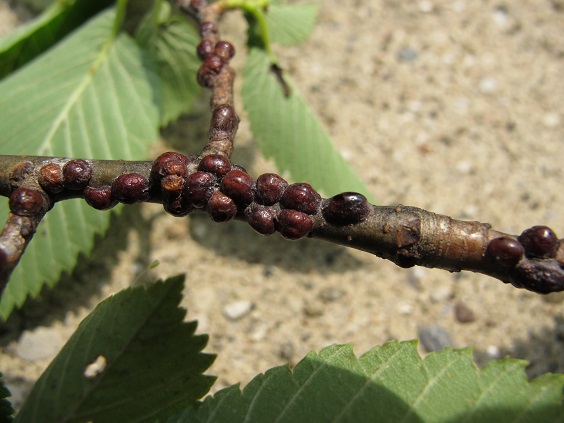–by Dr. Raymond Cloyd
European fruit lecanium scale (Parthenolecanium cornii) is noticeable on the twigs and branches of certain trees and shrubs in landscapes. Damage associated with this scale, which depends on the extent of the infestation, includes: plant stunting and wilting. The European fruit lecanium scale is a soft scale so honeydew (a sticky, clear liquid) will be produced during feeding. Honeydew attracts ants and serves as a substrate for black sooty mold. Moreover, honeydew can drip onto vehicles parked underneath infested trees leaving unsightly residues.
Figure 1. Close-Up of European Fruit Lecanium Scale (Author-Dan Potter, University of Kentucky).
Figure 2. European Fruit Lecanium Scale on Branch (Author-Dan Potter, University of Kentucky).
European fruit lecanium scales are dark brown and 1/8 to 1/4 inches in diameter when mature (Figures 1 and 2). Some scales may have white or dark markings on the body. European fruit lecanium scale overwinters as an immature on twigs and branches with maturation occurring in spring. Females lay eggs underneath her body from May through June. Eggs hatch into small tan-colored crawlers. The duration of egg hatch can last several days depending on temperature. Crawlers migrate to leaf undersides and feed on plant fluids until late summer. At that point, the crawlers migrate back onto twigs and branches to complete their development the following spring. There is one generation per year in Kansas.
European fruit lecanium scale management involves timely applications of insecticides. Applications need to be made when crawlers are present because the crawlers are the most vulnerable life stage to insecticide sprays. Mature scales possess a shell-like covering, which protects them from exposure to insecticides. Repeat applications will be required because the eggs do not all hatch simultaneously with eggs hatching over a three to four-week period. The best time to apply insecticides is late June through early July when crawlers are feeding on leaves, which enhances their exposure to any spray residues. There are a number of insecticides, with contact activity, that may suppress populations of the European fruit lecanium scale. However, many have broad-spectrum activity and consequently will kill many natural enemies (parasitoids and predators). In general, most out-breaks of scale insects are caused by the indiscriminate use of pesticides (insecticides and miticides). Therefore, always read the label and exercise caution when applying any pesticide. In the winter, dormant oils can be applied to kill overwintering scales by means of suffocation.
I need to acknowledge Jeff Otto and Matthew McKernan of Wichita, KS for bringing to my attention that European fruit lecanium scale was active.

